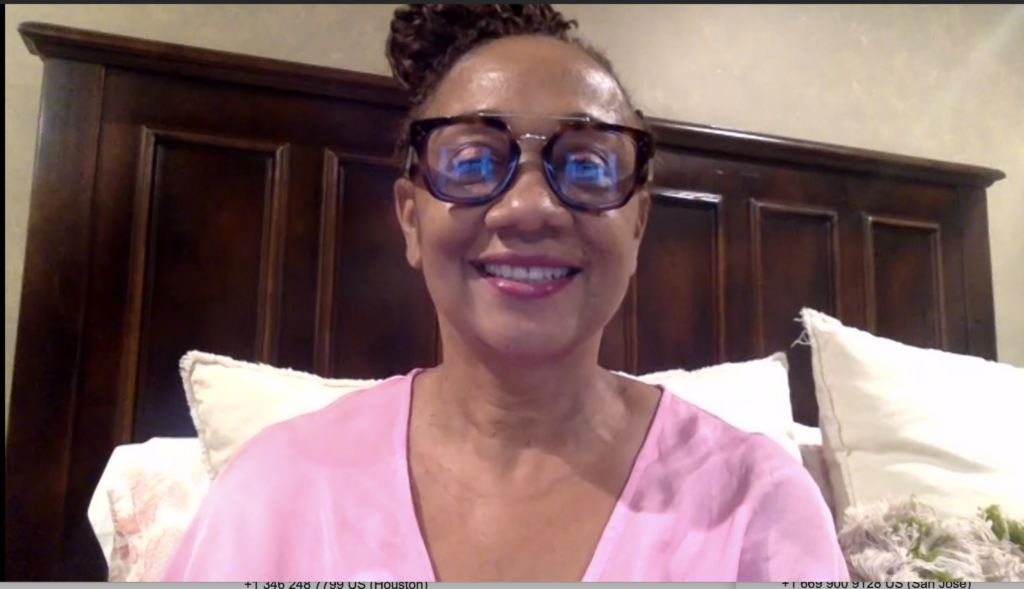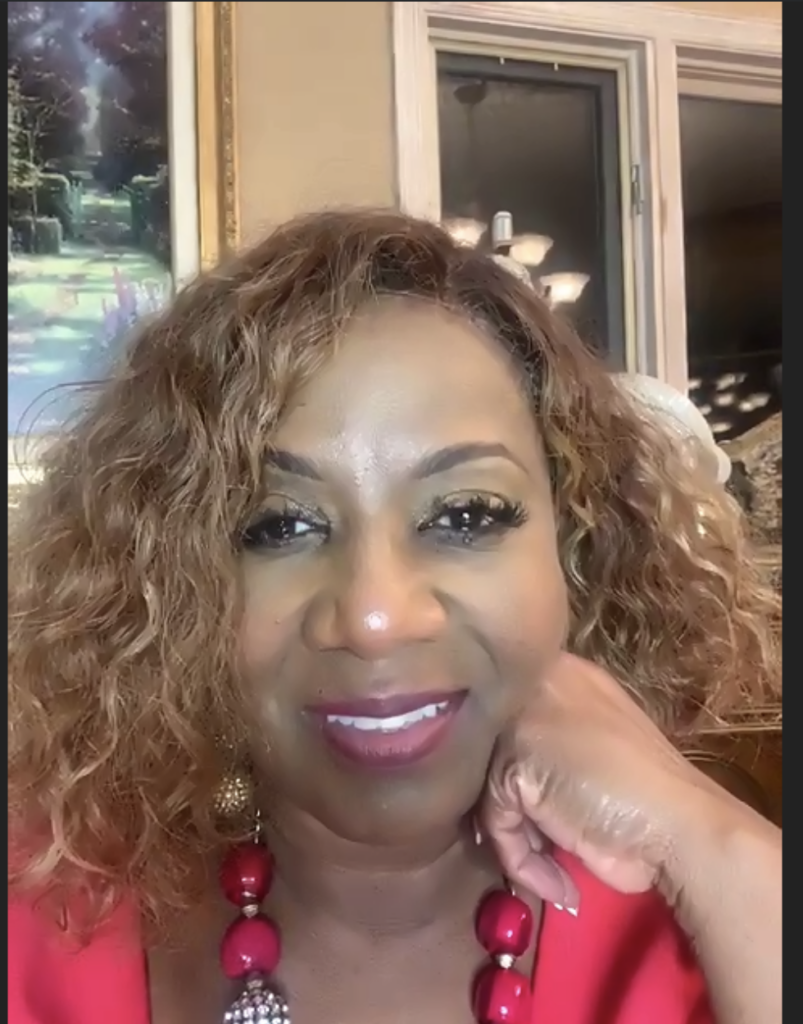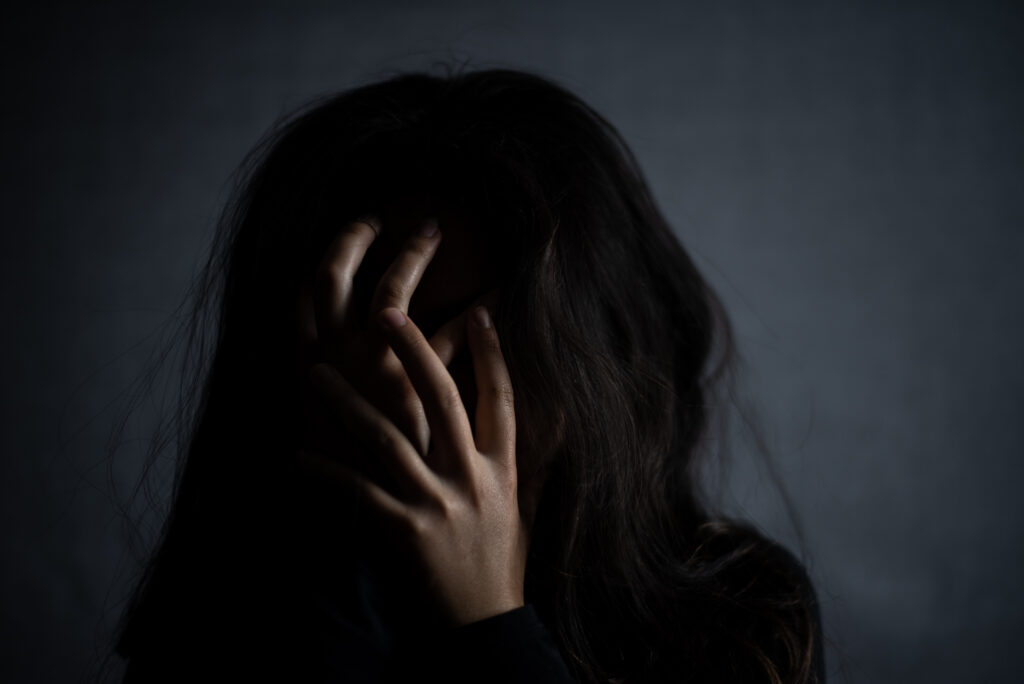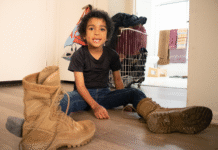
Lola Murphy. Screenshot by Paige Chestnut. 
Sandra Campbell. Screenshot by Paige Chestnut. 
Photo illustration by Katya Castillo.
Water goes down the drain.
This image, despite being a common, everyday visual, helps Lola Murphy deal with her anxiety.
Murphy, a 58-year-old entrepreneur from Calabasas, uses water as a metaphor to release her worries.
“I have this thing I tell myself when I let the water out of the drain that’s kind of like the Roto Rooter commercial,” Murphy said. “Troubles go down the drain. I say when this water goes out, then I’m going to be lighter—doesn’t mean my situation is going to be over, it just means I’m good. It’s not going to be as heavy as when I stepped into that water.”
Whether it is anxiety surrounding death, getting sick, losing income or loved ones, worries about COVID-19 have been stressful and nerve-wracking for many and may have exacerbated symptoms for those already struggling with anxiety.
Psychologist Carnetta Pryor works with patients who suffer from chronic anxiety and panic attacks. More than half of her clients suffer from anxiety.
“Because we’re all living in a very traumatic global experience, the uncertainty of it all and just the novelty of COVID-19 have really increased everyone’s anxiety,” Pryor said. “Some people were already kind of challenged with hypervigilance, or just worry and concern on a daily basis. COVID-19 has elevated that extremely.”
Murphy also uses mantras when she is at the beach. She tells herself that as the waves go in and out, so do her troubles. But she only pictures them going out instead of coming back in.
Murphy said she has always experienced anxiety but did not discover what it truly was until 2018, right before the marriage of her first child.
“I didn’t have a reference because I had never felt it before,” Murphy said. “Come to find out, I’ve always operated in anxiety. I just didn’t know what it was. So once it had a name to it, it made me nervous—even more nervous because I never had a name for it.”
Murphy has found that therapy significantly helps manage her anxiety. She also took up journaling as a coping mechanism. She said being able to talk to someone freely without fear of judgment helps her release her emotions.
“I get a chance to spill my guts to someone that is completely neutral, that allows me to get it out,” Murphy said. “You know people say journal, or even if you journal, burn it, that sort of thing, which I’ve started to do as well. But I was the kind of person who said I never wanted to journal because I don’t want to have my thoughts down for my family to read later and scare the crap out of them, for whatever reason. And my journaling is really not scary.”
Anxiety disorders are the most common mental illness among adults in the United States, with more than 18% of the adult population affected, according to the Anxiety and Depression Association of America.
Understanding their disorder can help people cope, as anxiety attacks and panic attacks differ. Pryor said educating her clients on the differences between the two is an essential step.
“Panic attacks really elevate the involuntary mechanism in the body,” Pryor said. “You start breathing heavier, your heart beats really fast and your pulse is running and racing. It can feel like you’re having a heart attack.”
The main difference between the two is that panic attacks often occur without a trigger, while an anxiety attack occurs in response to a perceived threat or stressor.
Unlike panic attacks, anxiety attacks are not recognized in the DSM-V (the Diagnostic and Statistical Manual of Mental Disorders), but they are still widely acknowledged and used to describe intense or extended periods of anxiety.
Sandra Campbell, a 62-year-old housewife from Calabasas, said she first experienced anxiety at 19, when she had her first child.
“You have a little bit of anxiety about every situation that you don’t really know about,” Campbell said. “And you’re going into a new situation. You don’t know what to expect. So, I believe that was part of it.”
The COVID-19 outbreak has impacted Campbell’s anxiety, especially when she was diagnosed with the virus.
“Thank God I basically had two symptoms,” Campbell said. “My nose got clogged and I was extremely tired. But part of it was all of the other things I had heard and other symptoms that people had, I’ve known several people who didn’t make it. So the mental part of it I think was worse than the physical part for me.”
Campbell had COVID-19 for three weeks and experienced a lingering fatigue, but now feels as if she’s starting to recover completely.
Her friends and family kept her calm throughout her diagnosis as well as her recovery. She has family members who work in the medical field, and she frequently met on Zoom with her women’s group for extra support.
“I have three RNs [registered nurses] in my family,” Campbell said. “One works in the emergency room at a particular hospital, so she walked me through things and talked me through things. When I got overwhelmed with my emotions, she would let me know what to expect and just reassure me that if I hadn’t experienced certain symptoms, I probably would not. So it helped calm me down. It’s kind of tough to do it.”
Campbell says being able to talk through her problems with her women’s group has helped her cope in the best way possible.
“You’re able to discuss whatever you’re going through which is amazing because what happens is, when you don’t have anyone to talk to, you feel like you’re going through things alone,” Campbell said. “So when you talk to other women who can say, ‘Listen, I’ve been through that and I made it and let me tell you what I did,’ they’ll give you tips on how to work whatever you’re going through. It helps to have a place to go, a place to land.”



